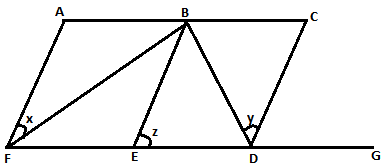MCQs
Communication Systems(12th Grade -Physics)
Total Questions : 167
| Page 2 of 17 pages
Answer: Option B. -> 54 kHz
:
B
mf = δfm=2250500 = 4.5
∴ New deviation = 2(mffm) = 2 × 4.5 × 6 = 54 kHz.
:
B
mf = δfm=2250500 = 4.5
∴ New deviation = 2(mffm) = 2 × 4.5 × 6 = 54 kHz.
Answer: Option B. -> Vertical type
:
B
Broadcasting antennas are generally vertical type.
:
B
Broadcasting antennas are generally vertical type.
Answer: Option A. -> 30-300 MHz
:
A
VHF (Very High Frequency) band having frequency range 30MHzto 300MHzis typically used for TV and radar transmission.
:
A
VHF (Very High Frequency) band having frequency range 30MHzto 300MHzis typically used for TV and radar transmission.
Answer: Option B. -> 5.0
:
B
The formula for modulation index is given by
mf=δvm=FrequencyvariationModulatingfrequency=10×1032×103=5
:
B
The formula for modulation index is given by
mf=δvm=FrequencyvariationModulatingfrequency=10×1032×103=5
Answer: Option B. -> 9.72 kW
:
B
Pt = Pc[1+m22] = 9 [1 + (0.4)22]
= 9 [1 + 0.162] (∵ m = 40 % = 0.4)
= 9 (1.08) = 9.72 kW
:
B
Pt = Pc[1+m22] = 9 [1 + (0.4)22]
= 9 [1 + 0.162] (∵ m = 40 % = 0.4)
= 9 (1.08) = 9.72 kW
Answer: Option C. -> 25%
:
C
ma=EmEc=1560×100 = 25 %
:
C
ma=EmEc=1560×100 = 25 %
Question 18. Read the assertion and reason carefully to mark the correct option out of the options given below:
Assertion :The electromagnetic waves of shorter wavelength can travel longer distances on earth's surface than those of longer wavelengths.
Reason : Shorter the wavelength, the larger is the velocity of wave propagation.
Assertion :The electromagnetic waves of shorter wavelength can travel longer distances on earth's surface than those of longer wavelengths.
Reason : Shorter the wavelength, the larger is the velocity of wave propagation.
Answer: Option C. -> Assertion is true but reason is false.
:
C
The electromagnetic waves of shorter wavelength do not suffer much diffraction from the obstacles of earth's atmosphere so they can travel long distance.
Also, shorter the wavelength, shorter is the velocity of wave propagation.
:
C
The electromagnetic waves of shorter wavelength do not suffer much diffraction from the obstacles of earth's atmosphere so they can travel long distance.
Also, shorter the wavelength, shorter is the velocity of wave propagation.
Answer: Option D. -> Medical treatment
:
D
Remote sensing is the technique to collect information about an object in respect of its size, colour, nature, location, temperatureetc.without physically touching it. There are some areas or location which are inaccessible. So to explore these areas or locations, a technique known as remote sensing is used. Remote sensing is done through a satellite.
:
D
Remote sensing is the technique to collect information about an object in respect of its size, colour, nature, location, temperatureetc.without physically touching it. There are some areas or location which are inaccessible. So to explore these areas or locations, a technique known as remote sensing is used. Remote sensing is done through a satellite.
Answer: Option A. -> 32000 bits/sec
:
A
If n is the number of bits per sample, then number of quantisation level = 2n
Since the number of quantisation level is 16
⇒2n=16⇒ n = 4
∴ bit rate = sampling rate × no.of bits per sample
= 8000 × 4 = 32,000 bits/sec
:
A
If n is the number of bits per sample, then number of quantisation level = 2n
Since the number of quantisation level is 16
⇒2n=16⇒ n = 4
∴ bit rate = sampling rate × no.of bits per sample
= 8000 × 4 = 32,000 bits/sec

















